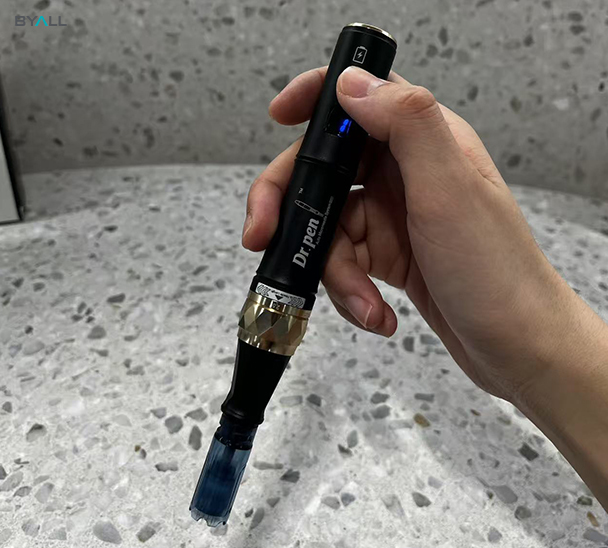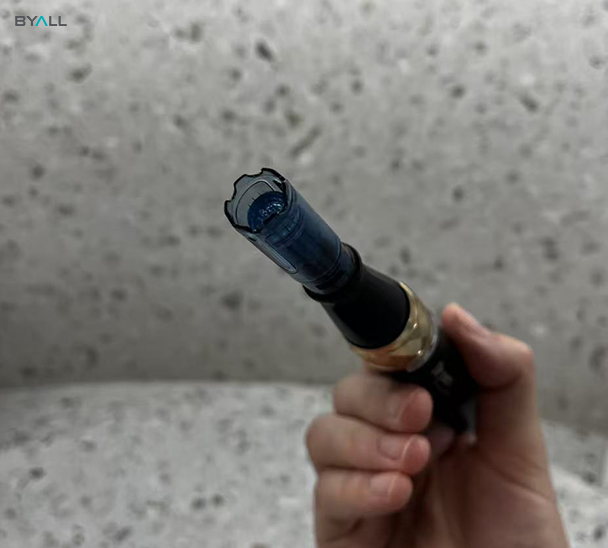Microneedling therapy is a minimally invasive cosmetic technique that offers a transformative solution for a wide range of skin concerns, including acne scars, fine lines, wrinkles, enlarged pores, and more.
By utilizing tiny needles to create controlled micro-injuries on the skin, this innovative treatment stimulates collagen production and promotes skin regeneration.
This comprehensive guide will provide you with detailed instructions on how to perform microneedling therapy at home for optimal results.
What is Microneedling Therapy?
Microneedling therapy, also known as collagen induction therapy or percutaneous collagen induction, is a procedure that involves puncturing the skin with tiny needles.
This triggers the body’s natural wound healing process, encouraging the production of new collagen and elastin.

The needles typically range from 0.5mm to 2mm in length, creating micro-punctures that penetrate the dermis—the layer of skin containing collagen and elastin fibers—without damaging the epidermis or upper layer of the skin.
This stimulation results in firmer, smoother, and more youthful-looking skin, effectively improving the appearance of scars, wrinkles, fine lines, enlarged pores, and uneven skin tone.
The Benefits of Microneedling Therapy
Here are some of the key advantages of microneedling therapy:

• Boosts collagen production, leading to tighter, more youthful skin
• Reduces the appearance of fine lines, wrinkles, and enlarged pores
• Improves the look of acne scars and stretch marks
• Evens out skin tone and texture
• Enhances the absorption of skincare products by increasing skin permeability
• Non-invasive procedure with minimal downtime
• Suitable for all skin types and tones
• More affordable compared to laser treatments
• Can be performed at home using a microneedling roller or pen
Who is a Good Candidate for Microneedling Therapy?
Microneedling therapy is ideal for both men and women seeking to enhance the appearance and feel of their skin.

It is suitable for all skin types and tones. The best candidates for microneedling therapy include those with:
• Fine lines and wrinkles
• Dull, uneven skin tone
• Enlarged pores
• Acne scars• Stretch marks
• Loose or sagging skin
However, microneedling therapy is not recommended for individuals who:

• Have used Accutane in the past 6 months
• Have open wounds, cuts, or skin infections
• Have undergone skin radiation treatment
• Suffer from certain medical conditions, such as hemophilia or cancer
Always consult with a dermatologist before trying microneedling therapy, especially if you have any underlying skin conditions.
How Does Microneedling Therapy Work?
During a microneedling treatment, a device with tiny sterile needles is moved over the skin, creating micro-punctures.

This triggers the skin’s wound healing response, increasing collagen and elastin production. Here’s a step-by-step breakdown of the treatment process:
1.Needles Penetrate the Epidermis and Dermis: The needles bypass the epidermis and reach the dermis, where collagen and elastin fibers are located. The depth of the needles can be adjusted based on the treatment goals.
2.Micro-Injuries Trigger Wound Healing: The tiny wounds created by the needles initiate the skin’s natural wound healing cascade. Growth factors are released, stimulating fibroblasts to produce more collagen and elastin.
3.Increased Collagen Plumps the Skin, Reducing Signs of Aging: The boost in collagen and elastin fibers leads to firmer, smoother, and more radiant skin. Collagen helps “plump” the skin from within, while elastin enhances skin elasticity.
4.Neoangiogenesis Improves Blood Circulation and Revitalizes the Skin: The micro-injuries also promote the formation of new blood vessels. This improves blood circulation and nutrient delivery, aiding in skin repair and revitalization.
5.Topical Skincare Products Penetrate Better: The micro-channels created by the needles allow skincare products like serums and creams to penetrate deeper into the skin, enhancing their efficacy.
How is Microneedling Therapy Performed?
Microneedling therapy can be performed in a clinic by a dermatologist or aesthetician or at home using a home microneedling device.
In-Clinic Microneedling Therapy

For in-clinic treatments, your dermatologist will use a professional microneedling pen with sterile needles ranging from 0.5mm to 2.5mm in length. To minimize discomfort, a numbing cream is typically applied before the treatment.
During the procedure, the microneedling pen is moved in a systematic pattern over the treatment area to create controlled micro-injuries.
The needles penetrate the skin precisely, depending on the needle size used. Longer needles (1.5mm – 2.5mm) are suitable for deeper scars, while shorter needles (0.5mm – 1mm) are ideal for superficial skin concerns.
The procedure is usually repeated 2-3 times in a single session, with intervals between each pass.
In-clinic microneedling treatments are supervised by a doctor to ensure the highest safety and effectiveness.
Multiple sessions spaced 3-6 weeks apart are typically required to see significant improvements.
At-Home Microneedling Therapy

For at-home treatments, a specialized microneedling roller or pen with needles up to 1.5mm in length can be used.
The needles must be sterile and disposable. The process involves gently rolling the microneedling pen over clean skin in different directions to evenly cover the treatment area.
Apply light pressure and treat each area 2-3 times. At-home microneedling is a more cost-effective option but may require more frequent treatments to achieve results comparable to in-clinic treatments.
Proper safety precautions and post-treatment care must be followed.
How to Prepare for Microneedling Therapy

Follow these steps to prepare your skin for a microneedling treatment:
• Avoid sun exposure for two weeks prior to reduce the risk of post-inflammatory hyperpigmentation
• Do not use retinoids for 48 hours to avoid irritation
• Stop exfoliating treatments like scrubs or peels about 5 days in advance
• Shave 1-2 days before if treating facial areas
• Wash your face with a gentle cleanser and pat dry before the procedure
• Apply a numbing cream 30-60 minutes before if desired, using a medical-grade product
• Avoid alcohol 24 hours before to minimize bleeding and irritation
• Do not tan for two weeks prior, as newly tanned skin is prone to hyperpigmentation
• Shave at least 24 hours before if treating the face, underarms, etc.
• Trim hair if treating areas like the scalp or legs for better treatment
• Remove contact lenses before the procedure

Step-by-Step Process for Microneedling Therapy
Follow these steps for an at-home microneedling treatment:

1.Clean and Disinfect the Skin• Wash your face with a gentle cleanser and pat dry with a clean towel. Do not rub.
• Wipe the treatment area with an alcohol-based disinfecting pad. Allow it to dry completely.
2.Apply Numbing Cream (Optional)
• If desired, apply a thin layer of numbing cream.
• Wait 30 minutes for optimal numbing before starting the needling.
• Clean again to remove the cream before needling.
3.Dr. Pen A8S – The Ultimate Professional Microneedling Device
• Dual Power Modes for Unmatched Flexibility: Enjoy the freedom of cordless operation with the long-lasting external battery, perfect for on-the-go treatments. Prefer uninterrupted sessions? Simply switch to plug-in mode for stable, continuous use.
• Smart LED Display & Low-Battery Alert: The intuitive LED speed display ensures precise control, while the low-battery reminder keeps your treatments on track—no surprises, just reliable performance.
• Advanced Safety & Performance Design: Anti-Backflow Needle Cartridge – Prevents serum leakage, protecting your device and enhancing hygiene.
Triple-Snap Lock Safety System – Secures needles firmly for safer, more effective treatments.
Wave-Groove Technology – Promotes even serum absorption, allowing deeper penetration for superior results.
• Luxury Meets Precision – Black & Gold Elegance: Designed for professionals who demand both performance and style, the sleek black-and-gold finish exudes sophistication.
4.How to Choose the Right Needle Length & Cartridge
• By Skin Concern:
0.2-0.3mm – Redness reduction, daily maintenance
0.3-0.5mm – Brightening, fine lines, general rejuvenation
0.5-1.0mm – Pigmentation, early wrinkles, firming, fresh acne scars
1.0-1.5mm – Pitted acne scars, deep wrinkles, stretch marks
1.5-2.5mm – Severe scarring, deep stretch marks, textured skin
• By Cartridge Type:
Nano-R / Nano-S (Micro-Tip Heads) – Pain-free, surface-level treatments (Nano-R covers larger areas).
Fewer Pins = Stronger Impact – Ideal for deep repair and faster results.
• Recommended Usage:
12pin / 18pin – Deep repair
24pin / 36pin / 42pin – Mid-layer treatments
Nano-R / Nano-S – Gentle surface rejuvenation
5.Microneedle the Treatment Area
• Tense the skin for better needle penetration.
• Roll evenly over the affected area in multiple directions. Apply light pressure.
• Treat each area 2-3 times, repeating multiple passes.
• Massage downwards from the forehead and neck. Roll outwards from the cheeks.
• Avoid repeatedly needling the same spot to minimize damage.
• If needling on dry skin, apply serum or oil for smoother gliding.
6.Cleanse Your Face Again After Treatment
• Rinse off the serum/oil with warm water and gently cleanse your face again.
• Pat dry gently with a clean towel. Do not rub the skin.
Post-Treatment Care
Following proper aftercare can enhance the results and healing process:

• No Active Ingredients: Avoid retinoids, alpha hydroxy acids, vitamin C, and other active ingredients for 24 hours as the skin is highly sensitive.
• Moisturize: Use a gentle, fragrance-free moisturizer to hydrate the skin and help soothe irritation.
• Sun Protection: Apply sunscreen with SPF 30 or higher for a week post-treatment. Limit sun exposure.
• Gentle Cleansing: Use warm water and a mild cleanser. Avoid harsh scrubbing.
• No Makeup for 24 Hours: Allow the skin to heal without clogging pores.
• No Sweating: Avoid strenuous exercise for 1-2 days.
• Hydrate: Drink plenty of water after the treatment.
• Serums: Hyaluronic acid, peptide, and growth factor serums can aid in healing.
• Cold Compress: Applying a cold compress to the skin can help reduce swelling or redness.
• Avoid Picking: Do not pick at dry skin or scabs, as this can lead to scarring.
How Often Should You Use Microneedling?
• For collagen induction, aim for 4-6 treatments spaced 4-6 weeks apart.
• For maintenance after initial treatments, perform microneedling every 4-8 weeks.
• Do not use a microneedling device more than once a week to avoid over-exfoliation.
• Adjust the frequency based on your skin’s sensitivity and recovery time.
Be patient and consistent for optimal anti-aging results. Combining with serums and moisturizers can enhance the effects.
Risks and Side Effects of Microneedling Therapy
When performed correctly, microneedling therapy is generally safe for most skin types with minimal risks. However, potential side effects include:
• Redness and tenderness for 2-4 days post-treatment
• Dryness, flaking, peeling, and itching as the skin heals
• Breakouts due to infection or improper aftercare
• Hyperpigmentation if the skin is not protected after sun exposure
• Scarring if needles are reused or treatments are too aggressive
Seek medical attention if you experience severe redness, bleeding, pain, or signs of infection. Overall, microneedling therapy is well-tolerated when proper techniques and aftercare are followed.
At-Home Microneedling vs. Professional Treatments
At-Home Microneedling
• More affordable option
• Needle lengths up to 1.5mm
• Requires more frequent sessions
• Higher risk of improper technique
• Primarily improves superficial skin concerns
Professional Microneedling

• Uses medical-grade devices with longer needles
• Administered by licensed aestheticians/doctors
• Better for deeper scars and wrinkles
• Lower risk of side effects and complications
• Offers additional treatments like PRP, radiofrequency, etc.
Discuss your specific skin goals with a dermatologist to determine if professional treatments are recommended over regular at-home sessions.
Conclusion

When performed correctly, microneedling therapy can significantly improve various signs of skin aging and damage by boosting collagen production.
For optimal results, use sterile needles, proper technique, and diligent aftercare. Be patient and consistent with your microneedling treatments. Combining with skin-repairing topicals can enhance the effects.
Always consult a doctor if you have any concerns. Microneedling therapy is a relatively safe, non-invasive treatment that, when incorporated into your skincare routine, can help reduce wrinkles, scars, hyperpigmentation, and other concerns.
Embrace the power of microneedling therapy and unlock your skin’s true potential for a radiant, youthful complexion.

From April 21st to 23rd, our sales elite team will be at Beauty World, held at the Riyadh International Convention & Exhibition Center in Saudi Arabia, eagerly awaiting your visit!
Come and immerse yourself in the unparalleled texture and exceptional usage experience of our products.
Our sales representatives will personally guide you through step-by-step usage tutorials, ensuring all your beauty concerns are addressed and alleviated.
For more information on our microneedling pens, visit the Dr. Pen comparison page or contact our knowledgeable customer service.
For the Dealers and Distributors, please don’t hesitate to contact us to get a direct factory price today!




